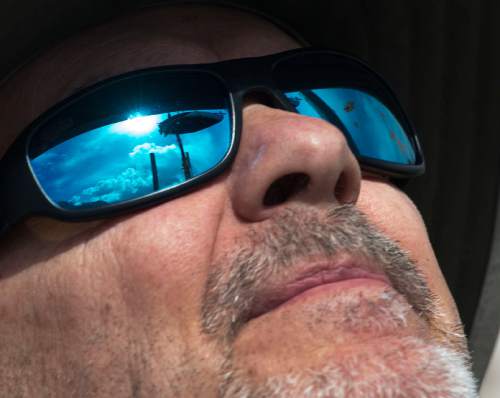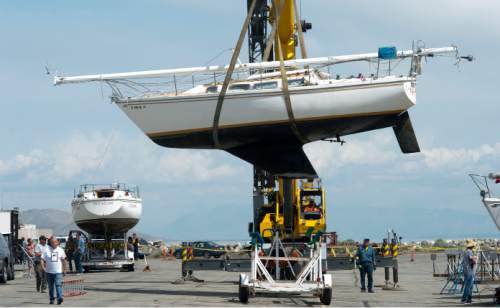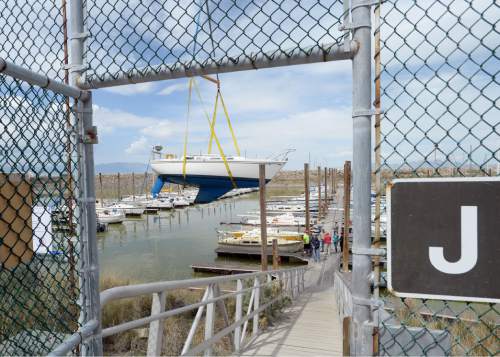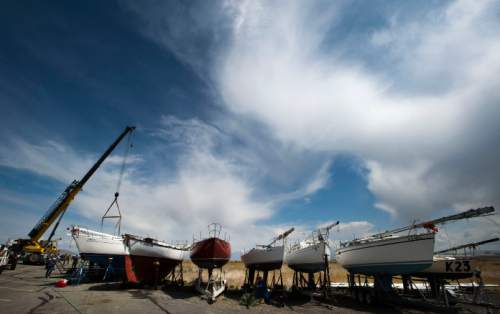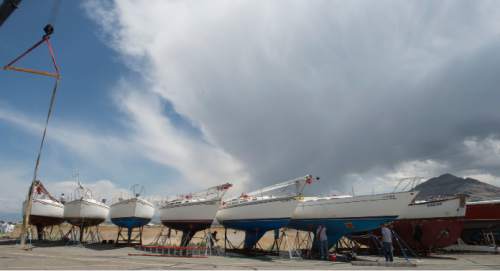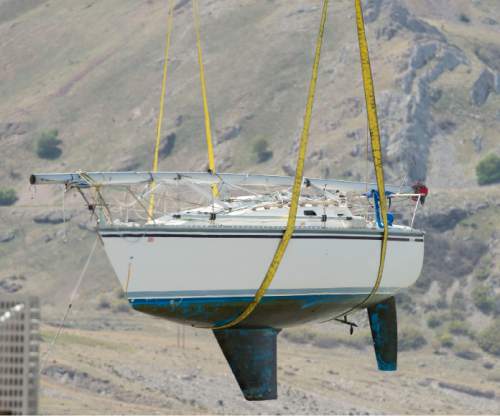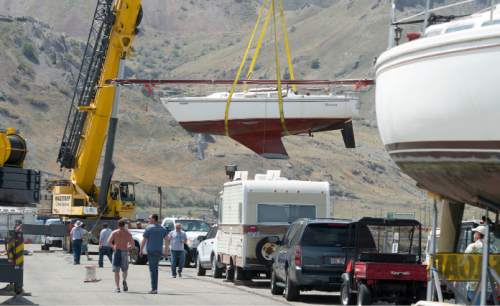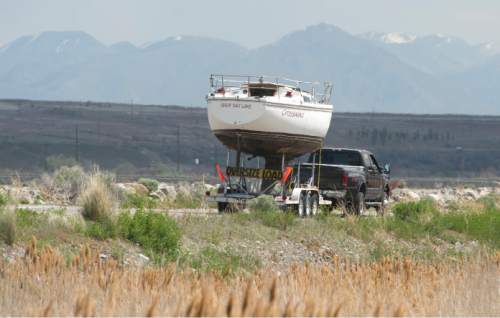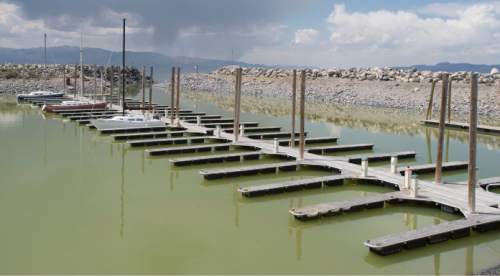This is an archived article that was published on sltrib.com in 2015, and information in the article may be outdated. It is provided only for personal research purposes and may not be reprinted.
Great Salt Lake • The saltiest sailors on the planet watched their sailboats get hoisted out of the Great Salt Lake Marina on Thursday and wondered when they might feel the rush of wind across the water again.
The only operating public marina on Utah's inland sea was hopping as state park managers, members of the Great Salt Lake Yacht Club, a crane company and the Coast Guard Auxiliary started the two-day process of lifting 80 sailboats out of the water and onto trailers or high cradles, where many of them will sit in the marina parking lot until the water in the lake is deep enough to handle the boats.
Sailboat owner Ron Lee said this was the most action his 10-ton boat Avalon has seen in a long time.
"I haven't been able to sail since Independence Day last year," Lee said, watching a boat being placed in a cradle. "I've had the boat for 10 years, and I haven't had a reason to take it out of the water.
"It's too heavy for a trailer," he added. "I'll leave it here until it can go back in the water."
Lee was sad to see his boat high and dry, but also optimistic, because the boats are being removed in preparation for a dredging project that should make it possible for his boat to get back in action.
This winter, Utah State Park officials asked lawmakers for money to dredge both the Great Salt Lake Marina and the marina at Utah Lake State Park.
The Legislature initially planned to provide funding for only one of the projects. At the time, State Parks Director Fred Hayes said the Utah Lake marina made more sense because it served more people.
Members of the Great Salt Lake Yacht Club fought for dredging to happen at their water, and the state ended up approving $3 million to complete both projects.
Money for the dredging is part of the state's fiscal 2016 budget and is not available until July 1. So the boats had to come out now.
"We are really happy we got the state to change their mind and give us the $1.5 million," said Jackie Harwood, of Park City. "This is a huge issue for us."
Harwood doesn't expect her 30-foot boat Teralani to be back on the lake until 2016 at the earliest, and likely 2017, due to low water levels across the lake.
"Even if we have a good winter, most of the water will probably go into the groundwater or reservoirs and not reach the Great Salt Lake," she said. "We just hope there is a change in the weather pattern."
Most years, sailboats would be going into the marina, but not this time.
"We started with the deeper draft boats that were already stuck in the mud or about to be stuck in the mud," said Great Salt Lake Marina Harbor Master Dave Shearer. "We are usually holding crane day this time of year to get boats on the water. Instead, we are taking them off."
Shearer said it will take time for the dredging contract to be awarded and for engineers to determine a plan for removing the mud.
"Hopefully they can take the deposited silt and maybe a little more from the bottom," he said, "and give us a little cushion for future low-water years."
Some boaters hope to be back on the Great Salt Lake by October.
If the dredging is completed by fall, Shearer said, another crane day will be organized to return the boats to the lake.
Other sailboat owners are not so optimistic.
Dan Cockayne bought his 22-foot sailboat Vortex at the marina more than a decade ago and never had a cause to take it from the water. He had to buy a trailer for Thursday's crane day.
"This lake has its ups and downs," Cockayne said. "You always think it will come back."
He took the boat home Thursday to park it and is pondering hauling it to Strawberry Reservoir for the summer. Or he might just put a "For sale" sign on it.
A 54-foot motor yacht, used to take people on commercial sunset dinner cruises, may be able to continue operating until early June, at best, Shearer said.
"We typically see the water in the marina rise 2 feet and then drop 2 feet," Shearer said. "Evaporation has already started to happen this year. We rose 1 foot and we might drop 3."
Twitter: @BrettPrettyman





